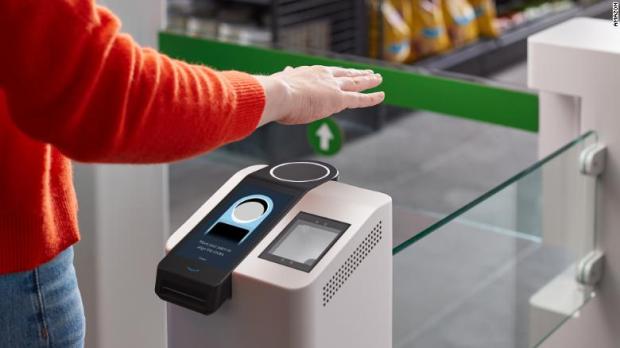Amazon Expands Palm Scan Payments in Bid for Grocery Shopper Loyalty

Amazon is adding pay-by-palm and smart carts to more grocery stores to drive brick-and-mortar adoption.
The eCommerce giant shared in an emailed announcement that it is adding its Amazon One palm scan payment technology to 11 Whole Foods Market stores in the Denver metropolitan area. Additionally, the company will make its Dash Cart self-service check-out-as-you-go shopping carts available at one of these locations, making it the fourth Whole Foods store to offer the option.
The move comes as Amazon looks to grow its share of perishable grocery sales by driving brick-and-mortar traffic.
On the company’s most recent earnings call, CEO Andy Jassy asserted that the extent of Amazon’s grocery presence tends to go underestimated, especially given its strength in packaged, shelf-stable products ranging from “paper products to canned goods to pet supplies to health and personal care items to consumables.” However, the company is weaker when it comes to items consumers typically purchase in stores.
“[We don’t] have a big market segment share in perishables, and if you really want to have significant market segment share in perishables, you typically need physical stores,” Jassy said.
Indeed, offering lower-friction checkout options such as these palm payments and smart carts can be key to winning the loyalty of grocery shoppers who are on the fence, according to research from PYMNTS’ latest Consumer Inflation Sentiment report, “Consumer Inflation Sentiment: The False Appeal of Deal-Chasing Consumers,” which drew from a survey of more than 2,100 United States consumers.
The study revealed that, while 17% of grocery shoppers remain loyal to their preferred merchants, and while 44% of grocery shoppers will go wherever they will get the best price, the remaining 38% are persuadables. That is, they consider several factors when deciding where to shop.
To secure the spending of those persuadable customers, it is key for grocers to remove friction from the shopping experience. The study found that persuadables rank ease and convenience above all other factors as most influential on their decision of where to buy groceries.
Consequently, grocers are in stiff competition in this respect, racing to offer the most simple, intuitive purchasing journey. Take, for instance, the emergence of curbside-only grocers, looking to speed up the shopping process for consumers by enabling them to build baskets and pay online, and then collect their orders on site within minutes.
In an interview with PYMNTS, Alex Ruhter, co-founder and CEO of curbside grocer JackBe, which announced last month that it raised $11.5 million in capital, contended that, once consumers are onboard, the model offers a much quicker shopping journey.
“We’re having to retrain people in one particular area, and it’s really the game changer for why JackBe has connected in the minds of the consumer, and it’s the fact that you do not have to schedule ahead in order to get groceries,” Ruhter said. “Any [other eGrocery channel] involves scheduling at some point in the future. With JackBe, you can place an order and then go pick up those items immediately.”
Meanwhile, brick-and-mortar grocers are trying everything from smart carts to own-device scan-and-pay to autonomous stores on the belief that, if they cannot step up their checkout and payment experiences, they will lose their customers. Indeed, research from PYMNTS’ study “Big Retail’s Innovation Mandate: Convenience and Personalization,” created in collaboration with ACI Worldwide, found that 68% of grocers think that consumers would be very or extremely likely to switch merchants if alternative payment methods in-store were not offer

